There are fewer family sedans on the market than ever; several major brands – including GM and Ford – no longer make them at all.
Toyota still makes one – and you can even get it with a keyed door (and ignition) lock. Not a fob – and a button – though those are available, if you’d like them.
So is a V6 engine option – something even fewer family sedans still offer. And a transmission with gears rather than ranges. How about buttons you can press rather than a screen you swipe?
It’s the Camry sedan – and it’s not exaggerating to say there’s no other family sedan that’s like it.
What It Is
The Camry has been the best-selling mid-sized family sedan for decades and is just about the only mid-sized family sedan still available with a V6.
Its long-time main rival and the second-best-selling family sedan, the Honda Accord, comes only with a four cylinder engine – and only with a continuously variable (CVT) automatic. The Camry’s automatic has gears and shifts and many people prefer this to a CVT’s ranges, that vary – continuously.
Honda also doesn’t offer an all-wheel-drive option with the Accord, which the Camry does.
And you can’t get an Accord with a physical key that manually turns a lock to open its doors – a feature very few new vehicles of any type offer at all. If you don’t want a fob – and the cost of replacing/reprogramming it after you run it through the wash – that alone might sell you on a new Camry.
Prices start at $25,045 for the base LE trim, which comes with a 203 horsepower 2.5 liter four cylinder engine paired with an eight speed automatic transmission. Front-wheel-drive is standard but you can opt for AWD, which bumps the price up to $26,445.
For a sportier looking (and handling) Camry, there’s the SE trim, which comes with a more aggressive 18 inch wheel/tire package and suspension tuning, plus paddle shifters on the steering wheel to manually control the eight speed automatic’s gear changing.
It stickers for $26,560 to start and once again, AWD is optional.
You can make the car look even sportier by opting for the nightshade package, which includes contrast black exterior trim detailing and a Nextel Cup-looking trunk mounted spoiler.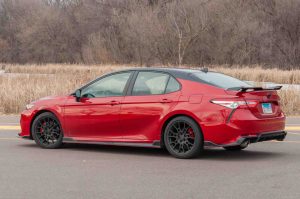
For sportier-running and looking, there’s the top-of-the-line Camry TRD (Toyota Racing Development ).
It comes standard with the 301 horsepower 3.5 liter V6 that’s optional in the XLE ($29,945 to start) and XSE ($30,495) trims and an even more aggressive 19 inch wheel/tire package, TRD performance-tuned exhaust and a full-boogie exterior body kit in addition to the rear spoiler and special bolstered sport buckets with red seat belts and TRD trim inside.
This ultimate Camry stickers for $32,260.
All V6-equipped Camrys are front-wheel-drive only.
What’s New
A larger (9 inch) LCD touchscreen is available and all trims get minor exterior/interior cosmetic tweaks.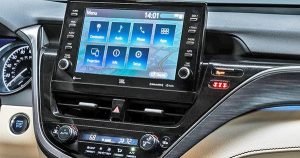
What’s Good
The only sedan among its peers that doesn’t rely on turbocharging for horsepower – and that still offers V6 power.
Outstanding visibility and comfort.
An LCD screen with actual buttons to touch.
What’s Not So Good
Optional AWD is only optional with the four cylinder engine.
Optional V6 is not available with sporty SE trim.
Dodge offers a standard V6 in the Charger sedan – and it’s available with rear-wheel-drive or all-wheel-drive.
Under The Hood
The Camry comes standard with a 2.5 liter four cylinder engine that makes 203 horsepower. This engine is paired with an eight speed automatic and either FWD (standard) or AWD (optional).
A few points of interest about the Camry’s standard drivetrain.
The first being that the four does not have a turbo and yet makes more horsepower than its most-immediate-rival’s standard (and turbocharged) engine. The 1.5 liter turbocharged engine that is the Honda Accord’s standard engine only makes 192 horsepower, 11 less than the Camry’s four. It’s also only margin-of-error more fuel efficient, rating 30 city, 38 highway vs. the Camry four’s 28 city, 39 highway. And it comes paired with a CVT automatic, a type of transmission that supposedly improves fuel efficiency but which some people dislike because it doesn’t shift – because it doesn’t have gears. It has ranges that vary, continuously. This gives a different feel as well as a different sound, especially during full-throttle acceleration and passing, about which more below.
The Accord also does not offer AWD – with either of its two turbocharged four cylinder engines. The Mazda6 sedan – which has (sadly) been cancelled – and the Hyundai Sonata and Nissan Altima sedans, two of the other main players in the class – are also four cylinder and FWD-only.
The Camry is available with a 3.5 liter V6 that makes 301 horsepower – also paired with an eight-speed automatic.
But this combo is only offered with AWD.
The Dodge Charger sedan comes standard with a V6 (3.6 liters, 292 horses) and it’s available with AWD. But it’s a bigger (longer) and much heavier car (by nearly 600 pounds).
It is also a rear-drive car, as it comes.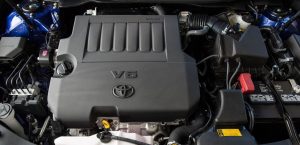
Not that there’s anything wrong with any of that. The Charger is a great car, if you prefer heavyweight, traditional American cars. But it’s a very different car in feel – and layout – than the Camry (and Accord and Mazda6 and Hyundai Sonata, et al).
The Charger excepted, the Camry rules this roost. Even with its optional turbocharged 2.0 liter four, the Honda Accord maxes out at a comparatively feeble 252 hp – though this engine is paired with a conventional (ten speed) automatic transmission. The Hyundai Sonata N Line is the next-closest thing. It comes with a turbocharged 2.5 liter four cylinder engine that makes 290 horsepower.
But if you want a V6 in a family sedan like the Camry, you pretty much have to buy a Camry.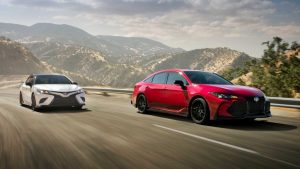
On The Road
Before the return of heavyweight traditional American sedans like the Charger, the Camry was the most traditionally American-feeling car on the road. Quiet, smooth and exceptionally comfortable – whereas most of its American-badged rivals emulated the sportier ride and handling feel of traditional Japanese/European-badged cars.
The Camry remains one of the most comfortable-to-drive cars on the road, with softness that rivals and even exceeds that of much more expensive luxury cars of all badges, which almost universally emulate the luxury-sport ethos that BMW started back in the ’80s and which somehow became a kind of benchmark for all cars. Which is a strange thing since luxury and sport are at odds. Like being bulky and agile at the same time. It is possible, but not easy – and most of the time results in awkward compromises.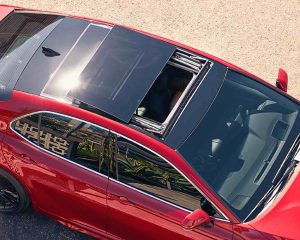
The Camry manages to toe the line better than most. The current model is much sportier than previous models – especially in terms of how it looks and also in terms of how it handles, particularly the SE and TRD versions of it, which have firmer suspension calibrations and short-sidewall tires that have less give, which is good for steering sharpness, especially.
But is also more luxurious – in terms of its softness – than others in the class and even some in the much-more-pricey luxury class, which continue to fixate on being at least as sporty as they are luxurious.
To drive the Camry is to like the Camry. The seats complement the suspension and the exceptionally good visibility, particularly to the sides – because of all that glass and so a lot less metal in the way of your view – makes pulling out from side streets much more relaxing than doing it in a car that’s harder to see out of – because of all that metal enveloping you.
And – surprisingly – the Camry’s standard “assistance” tech, including Lane Keep Assist and Forward Collision Mitigation (same basic thing as automated emergency braking) is not insufferably peremptory, as it is in many more aggressive cars. In a week of driving, I hardly noticed them because they hardly ever assaulted me with buzzers, lights and other such disturbances . Even the seatbelt buckle-up reminder isn’t nearly as obnoxious as it is in most other new cars.
Why is this surprising? Because the Camry is the apotheosis of the family sedan and you’d assume that because of that, all the “safety” and “assistance” tech would be hyper-sensitive.
It isn’t.
And there is no automated stop/start. The engine runs until you turn it off.
Another blessing!
The Camry’s standard four isn’t ferocious but it is stronger than all of its main rivals’ standard fours and approaches the strength of several of its rivals’ optional engines. And its transmission shifts, which some of its rival’s transmissions don’t. If you dislike CVTs, you will like the Camry’s not having one.
With its optional V6, the Camry is pretty ferocious. Zero to 60 in about 5 seconds flat for the TRD version – and not just the TRD version, which has the most ferocious look. Other V6-equipped Camrys look less ferocious but are powered by the same V6 and are just as actually ferocious.
The TRD Camry merely sounds a bit more ferocious, due to its more aggressive exhaust system.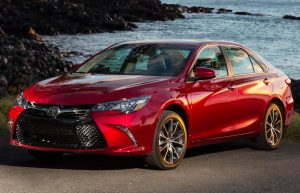
At The Curb
For a long time, the Camry’s looks were easy to not see. More finely put, it was a car that didn’t call attention to itself by how it looked but by the goodness it embodied.
People bought Camrys for their Swiss watch dependability, their lower-and-slower-than-most depreciation rates and because they have always been exceptionally pleasant, easy-to-live-with cars. They were like a favorite pair of shoes you wore for years and felt sad about parting with when you finally had to get a new pair. Which – when it came to Camrys – was usually a long time after you bought one.
The Camry still is all of those things – including (probably) even more long-term dependable than its turbocharged and arguably over-teched rivals.
A car you do see.
Toyota took a great risk by amping up the Camry’s look. A too aggressive (or too weird) look could easily have alienated traditional Camry buyers while not attracting new ones, many of whom are probably interested in a more actually aggressive car – if they are attracted to ultra-agro looks.
As with the car’s ride and handling, Toyota struck a balance that isn’t likely to off-put the traditional buyer while also giving new buyers something more than just dependability and pleasantness to look at.
Plus, of course, the practicality that has made the Camry not only popular but also a survivor. It may not have as much room for cargo as a crossover, but it does have a 15.1 cubic foot trunk that can be made larger by using the pass-through to the passenger area. Which isn’t just a hole between the two rear seatbacks.
You can fold down the entire upper portion of the driver’s side rear seat.
This opening can be used to accommodate a bundle of eight-foot-long 1x2s with the trunk fully closed. The Camry’s trunk is also almost as large as the much larger-itself Dodge Charger, which has a 16.5 cubic foot trunk and is 198.4 inches long overall vs. 192.1 inches overall for the Camry.
Another manifestation of the Camry’s balancing act is its LCD display. It is like other displays except that it (unlike almost all of the others) also has actual (physical) buttons on either side that you can press to access/activate the various apps and functions – as opposed to fumbling with a purely smartphone-emulating tap/swipe an image/icon to do the same, which is harder to do by feel.
Same goes for the stereo controls. You can adjust the volume – and change the station – by hand (using knobs) which is much easier to do without looking than tapping and swiping. The Camry is as “hip”and “with it” as any other new car in terms of its tech. It’s just got easier to use tech.
Speaking of which.
It is almost as hard to find a new car with a keyed exterior door lock (and a keyed ignition lock) as it is to find a new car without a catalytic converter.
Fobs – and push-buttons are the in thing. But when you forget these in things in your pocket and run them through the wash, they may no longer open the door – or start the engine. A physical stick-it-in key is much harder to hurt and if you lose it, much less expensive to replace.
The Camry is available with either one, so you can choose which you prefer.
Which is ultimately what the Camry is all about. A choice of engines. The choice to not have a four cylinder engine, a turbocharged engine or a CVT transmission. The choice to push buttons rather than have to swipe and tap at screens.
The Bottom Line
All of which accounts for why so many people have chosen a Camry. And why many will probably choose one again.
. . .
Got a question about cars, Libertarian politics – or anything else? Click on the “ask Eric” link and send ’em in!
If you like what you’ve found here please consider supporting EPautos.
We depend on you to keep the wheels turning!
Our donate button is here.
If you prefer not to use PayPal, our mailing address is:
EPautos
721 Hummingbird Lane SE
Copper Hill, VA 24079
PS: Get an EPautos magnet or sticker or coaster in return for a $20 or more one-time donation or a $10 or more monthly recurring donation. (Please be sure to tell us you want a magnet or sticker or coaster – and also, provide an address, so we know where to mail the thing!)
My eBook about car buying (new and used) is also available for your favorite price – free! Click here. If that fails, email me at [email protected] and I will send you a copy directly!




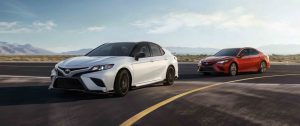
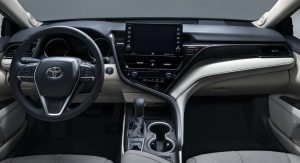
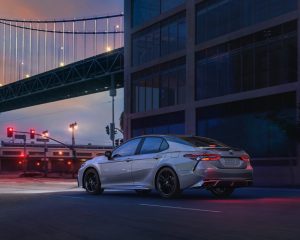








Toyota has hit a home run with this car. I hope they extend it for a few years. The styling is excellent as well as the power plant choices. I wish I could buy one right now. This iteration has been around since 2018. I rented one that Christmas holiday and found it a fine driving car. At 85 mph I was still getting around 30 mpg. At 70, it was close to 40. That was with a large displacement 4. As Eric points out, it is nice to see a car with a large greenhouse. Overall handling was very good and stability excellent. You could cruise at 100 all day long.
If Toyota keeps it around, it will begin to sell even better when sedans become popular again. Gas over $3.50 changes car buying habits.
When my Lexus wears out, one of these will be in the garage, all the safety crap on it notwithstanding
You forget all the times you actually don’t want an electric key in your pocket that can be damaged in the water.
Talking about nannied cars brings this article to me. Enclosed is the link to a new Suzuki sold in Australia without all the nanny features, no touchscreen, just a radio with cd player.
https://www.news.com.au/technology/motoring/motoring-news/2021-suzuki-jimny-lite-australian-details-revealed/news-story/9141da47fd1afebb8ab30105260bbc4c
I purchased a few months ago a 2021 Camry SE FWD 2.5, and I couldn’t agree more with everything Eric is saying. Best car I have owned.
Good stuff, Anon!
I don’t often snuggle up to new cars but the Camry is an exception. It is a truly stupendous vehicle, especially given the pressures of the new car market (which is becoming less and less a market, thanks to the government.) Toyota has more balls than GM and Ford put together.
‘the best-selling mid-sized family sedan for decades’ — EP
That described the Chevrolet Impala in the 1960s: baseball, hot dogs, apple pie and Chevrolet.
First GM laughed at the pitiful, cheesy little Japanese econoboxes.
Then GM woke up flat on the ground, wondering who the hell punched its lights out.
Not to give away the plot, but stay tuned for the EV sequel. Biff, bop, pow!!!
Why AWD with only the 4 banger?
seems like a disappointment
Seems it could move itself into the bad ass category with rear wheel and those looks, but I guess that’s not who they build for.
and I do appreciate an actual car in this wash of cloned crossovers
Eric,
The Camry’s key, like mine, has the fob BUILT IN to it; thankfully, the blade is still there, so you can still operate the Camry the old fashioned way if the battery runs out… 🙂